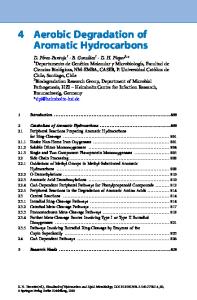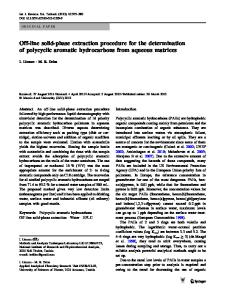Sorption Preconcentration and Determination of o -Xylene and Polynuclear Aromatic Hydrocarbons in Atmospheric Precipitat
- PDF / 644,519 Bytes
- 6 Pages / 612 x 792 pts (letter) Page_size
- 67 Downloads / 313 Views
CLES
Sorption Preconcentration and Determination of o-Xylene and Polynuclear Aromatic Hydrocarbons in Atmospheric Precipitates by Gas Chromatograpgy–Mass Spectrometry K. S. Guteneva, T. I. Tikhomirovaa, *, and V. N. Belyaevb, ** aDepartment
of Chemistry, Lomonosov Moscow State University, Moscow, 119992 Russia International Analytical Center, Institute of Organic Chemistry, Russian Academy of Sciences, Moscow, 119991 Russia *e-mail: [email protected] **e-mail: [email protected]
b
Received December 24, 2019; revised February 5, 2020; accepted March 11, 2020
Abstract—The conditions of the sorption concentration of o-xylene and polynuclear aromatic hydrocarbons (PAHs) on hypercrosslinked polystyrene in the dynamic mode are developed. A procedure is proposed for the determination of o-xylene and PAHs in thawed snow, based on the sorption preconcentration of these compounds and their further determination by gas chromatography–mass spectrometry. Samples of thawed snow taken in the park of Moscow State University are analyzed. Keywords: thawed snow, sorption concentration, hypercross-linked polystyrene, ecotoxicant, gas chromatography–mass spectrometry DOI: 10.1134/S1061934820090117
A huge amount of substances of varying degrees of toxicity enters the environment as a result of human activity. For most natural samples, standard concentrations of ecotoxicants are regulated, but no standards were prescribed for atmospheric precipitates. This is due to the small amount of data that allow researchers to come to conclusions about the effect of atmospheric precipitates on other natural samples and humans. It is known that the following organic substances can be contained in atmospheric precipitates: alkanes up to C36, alkenes, fatty acids (palm and stearic acids) [1], toluene, ethylbenzene, xylenes, trichloroethane, tetrachloroethane [2, 3], biphenyl [1, 3], dibenzofuran, fluorene, anthracene, dibenzothiophene [1, 2], naphthalene, phenanthrene, pyrene [1‒3], acenaphthene [2], α-hexachlorocyclohexane [2, 4], and benzo(a)pyrene [2, 3]. The amount of many compounds in atmospheric precipitates is too low for their direct determination and reaches the level of trace amounts (pg/L). To determine such low concentrations of substances, it is necessary to use preconcentration and highly sensitive methods of analysis. In most cases, liquid–liquid extraction is used to preconcentrate ecotoxicants in the analysis of atmospheric precipitates. Gas and liquid chromatography with mass spectrometric detection are used as the main methods of analysis. The most common extraction preconcentration is characterized by a number of significant drawbacks.
As a rule, the distribution factors of microcomponents are not high, the use of toxic organic solvents is required, and the process is difficult to automate. Thus, in extraction according to the method 8270 of the United States Environmental Protection Agency, for 1 L of sample, it is necessary to use 60 mL of dichloromethane, and extraction is repeated three times, which makes this
Data Loading...











